Bb8.2
Since the time when the Virgin - characterized by Vindemiatrix
and Spica, corresponding to the Babylonian figures named Frond
and
Furrow -
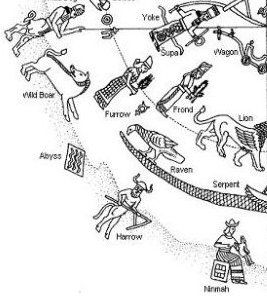
had been at the equinox her position had gradually
changed through the millenia by being pushed later and later in the Sun
year:

And like Raven she had loitered (later'd) at the Tree
→ Crux. The silhouette of Raven was
there for everyone to see down in the southwestern (toga)
quadrant of Crux (although nowadays changed to be in the
northwestern quadrant of the Sun year):
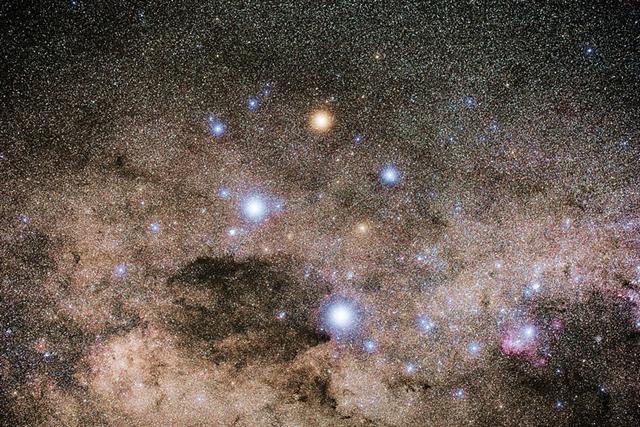
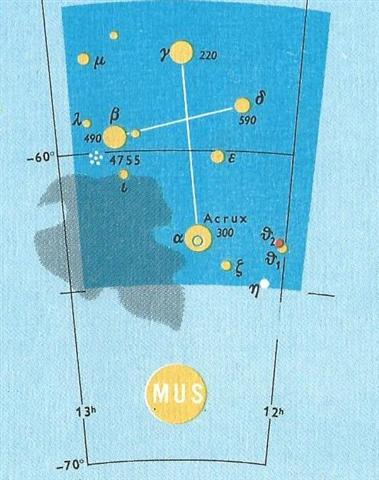
Acrux (*187) was at the Full Moon 4 days before Porrima (*191),
which meant 5 days before Mimosa (*192) above the dark figure of
the Raven:
 |
 |
 |
|
Bb6-32 (656 = 16 * 41) |
Bb6-33 (236 =
8 * 29½) |
Bb6-34 |
|
ko te maitaki |
kua rere te manu - mau i te
poporo |
ko te manu kua mau i te
poporo |
|
March 21 (0h) |
22 (81) |
23 |
|
Al Fargh al Thāni-25 (Rear Spout)
0h (365.25)
CAPH (Hand) =
β
Cassiopeiae,
SIRRAH (Navel of the Horse) =
α
Andromedae
(0.5),
ε
Phoenicis,
γ³
Oct.
(0.8) |
Uttara Bhādrapadā-27 (2nd
of the Blessed Feet) /
Wall-14 (Porcupine)
ο Oct. (1.3),
ALGENIB PEGASI = γ Pegasi
(1.8) |
χ Pegasi (2.1), θ Andromedae (2.7) |
|
Sept 19 |
20 |
21 (264) |
|
12h (182.6)
ο
Virginis (182.1),
η
Crucis (182.5) |
ALCHITA =
α
Corvi, MA WEI (Tail of the Horse) =
δ
Centauri
(183.1),
MINKAR =
ε
Corvi
(183.7),
ρ
Centauri (183.9) |
PÁLIDA (Pale) =
δ
Crucis
(184.6),
MEGREZ (Root of the Tail) =
δ
Ursae Majoris
(184.9) |
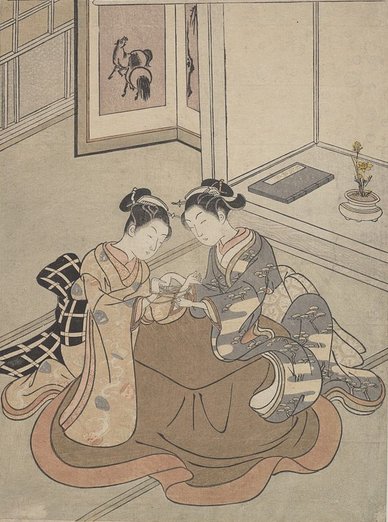 |
 |
 |
 |
|
Bb6-35 |
Bb6-36 |
Bb6-37 (240) |
|
ka oho te tagata |
kua oho ki mua kia ia |
kai tae e oho |
|
March 24 |
25 |
26 (85) |
|
σ Andromedae (3.0), ι Ceti (3.3), ζ Tucanae (3.5), ρ
Andromedae, π Tucanae (3.7) |
No star listed (4) |
ANKAA =
α
Phoenicis,
κ
Phoenicis (5.0)
ALPHARD (α Hydrae) |
|
Sept 22 (Equinox) |
23 (266) |
24 |
|
Hasta-13 (Hand) /
Chariot-28 (Worm)
GIENAH (Wing) =
γ
Corvi
(185.1),
ε
Muscae (185.2),
ζ
Crucis (185.4), ZANIAH (Corner) =
η
Virginis
(185.9)
*144.0 = *185.4 - *41.4 |
CHANG SHA (Long Sand-bank) =
ζ
Corvi
(186.3) |
INTROMETIDA (Inserted) =
ε
Crucis (187.4),
ACRUX =
α
Crucis
(187.5)
*146.0 = *187.4 - *41.4 |
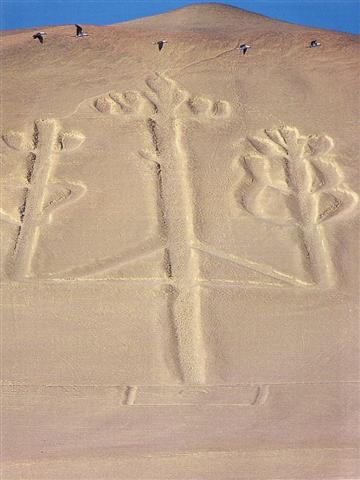 |
 |
 |
 |
|
Bb6-38 |
Bb6-39 (242) |
Bb6-40 (664) |
|
ka rere te manu |
ki te hakanohoga o te tahito |
koia |
|
March 27 |
28 |
29 (88) |
|
λ Phoenicis (6.3),
β
Tucanae (6.4)
*6.4 - *41.4 = *147.0 - 182.0 =
- *35.0 |
ANDROMEDA GALAXY (M31),
π Andromedae (7.7) |
ε Andromedae (8.2),
DELTA =
δ Andromedae (8.4), SCHEDIR (Breast) = α Cassiopeiae
(8.6), ζ Andromedae, μ Phoenicis (8.9)
*8.4 - *41.4 = *149.0 - 182.0 =
- *33.0 |
|
Sept 25 |
26 |
27 (270) |
|
γ Com. Berenicis (188.0), σ Centauri (188.1),
ALGORAB = δ Corvi
(188.5),
GACRUX = γ Crucis
(188.7) |
γ
Muscae (189.0),
AVIS SATYRA (Bird of the Satyrs) =
η
Corvi
(189.3),
ASTERION (Starry) =
β
Canum Ven.
(189.5),
KRAZ = β Corvi,
κ Draconis (189.7) |
α Muscae (190.2), τ Centauri (190.5), χ Virginis
(190.7)
ALDERAMIN (α Cephei) |
 |
 |
 |
 |
|
Bb7-1 (244
→
300 - 56) |
Bb7-2 (666
→
722 - 56) |
Bb7-3 (273 +
365 + 29) |
|
Ku rere mai ki te manu |
e tagata hakanaganaga ia ra |
mai tae moe |
|
Tae. 1. Negation used in
conditional and temporal clauses: ana ta'e
hoa te ûa, ina he vai, when it does not
rain, there is no water. Also used with some
verbal forms such as: o te aha koe i-ta'e-oho
mai-ai? why didn't you come? Otherwise its
use is limited to adjectives or verbal
adjectives: tagata ta'e hupehupe, person
who is not weak, hard worker; nohoga ta'e
oti, endless existence, eternity. 2.
Interjection expressing admiration, always used
with he: ta'e he tagata! what a
man! Ta'e he aga! what a great job!
Ta'e he tagata koe mo keukeu i te henua!
what a good farmer you are! Vanaga. 1.
Prepositive negative: without, not, none. PS
To.: tae, prepositive negative. 2. To
remain; tae atu ki, as far as, until.
Taehaga (tae 1), to shake the head in
sign of negation, reluctant, to disdain, to be
displeased. 3. Pau.: tae, to arrive.
Mgv.: tae, id. Ta.: tae, id. Ma.:
tae, id. 4. Pau.: taetae,
elephantiasis in scroto. Ta.: taetae,
ill, illness. Churchill.
Mai. 1. From, since;
mai aganirá pemu'a from now on. 2. Before,
prior to (referring to a future event certain to
occur); mai ta'e oho au ki-Hiva, prior to
my leaving for the continent (note the use of
the negative, lit. 'before I do not go...'. 3.
Short for ka-avai-mai, mai te kahu,
give me the dress. 4. Hither (movement towards
the speaker); ka-ho-mai (= ka-oho-mai),
come here! welcome! hoki-mai-á e îa, he
has come back; ina kai garo'a-mai, he
cannot understand it; ka-to'o-mai, come
and get it. Vanaga.
Moe. To sleep, to lie at full length,
to dream, to brood, to place, to cohabit; moe
atu, to leave off, to desist; moe atu ra,
to adjourn, to postpone; moe hakahepo, to
talk in the deep; moe aherepo,
somnambulist, sleepwalker; moe
hakataha, to sleep on the side; moe no,
to oversleep, concubinage; moe tahae, to
be a light sleeper; moe tahaga, a
sleeper; moe vaeahatu, moe hakaroa,
to sleep sprawling; rava moe, to sleep
sound; ariga moe ki raro, to lie
flat on the ground; tae moe, bachelor;
hakamoe, to brood, to fold the wings; to
reserve, to lay up; to struggle. P Pau.: moe,
sleep. Mgv.: moe, sleep, to lie down,
coitus, to shut the eyes. Mq.: moe, to
sleep, to lie down; haámoe, to set down
on the ground. Ta.: moe, to sleep, to lie
down. Moea raruga, lying flat. Moeaivi,
thin. Mq.: ivi, haáivi, id. Ta.:
ivi, id. Moega, mat. Pau.:
moehega, bed. Mgv.: moega, a sleeping
mat. Mq.: moena, moeka, mat, floor
cloth, bed. Ta.: moea, bed. Moemata,
to sleep with the eyes open; mea moemata,
phantom. Moemoea, a dream, vision;
tikeahaga moemoea, apparition by
night. T Mgv., Mq., Ta.: moemoea, dream.
Churchill. Mgv. Moemoe, to steal, to
purloin at a food distribution. Mq.: moemoe,
to seize, to grasp. Churchill. Ta.: 1.
Moemoe, ambush. Ha.: moemoe, id. 2.
Moemoe, Phyllanthus simplex. To.:
mohemohe, a tree. Churchill. Mq.: Moehu,
exiled, banished, prisoner of war. Ma.:
morehu, a survivor. Churchill. |
|
March 30
(454) |
31 |
April 1 (456
= 365 + 91) |
|
"May 8 (48) |
9 |
10 (50 = 91 -
41) |
|
JAN 25 (390) |
26 |
27 (392 = 91
- 64) |
|
HELIACAL
STARS: |
|
ξ
Phoenicis (9.0),
ρ
Tucanae (9.1),
DENEB KAITOS (Tail of the Sea Beast) =
β
Ceti,
η
Phoenicis (9.4), AL NITHĀM (String of Pearls) =
φ¹
Ceti
(9.6)
*9.4 - *41.4 = *150.0 - 182.0 =
- *32.0 |
ACHIRD (Woman with Luminous Rays) =
η
Cassiopeiae
(10.7) |
Legs-15 (Wolf)
ν
Andromedae (11.0),
φ²
Ceti (11.1),
ρ Phoenicis (11.2),
η
Andromedae (11.4)
*335.0 = *11.4 - *41.4 |
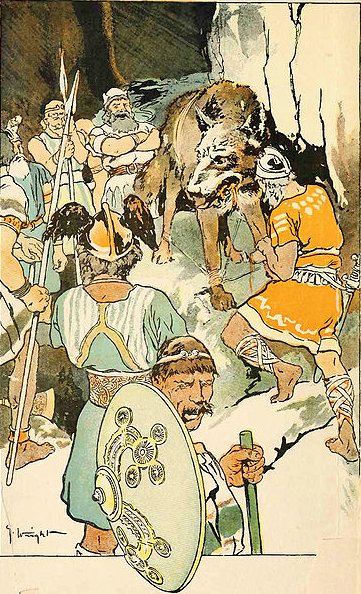 |
|
RIGHT
ASCENSION DAYS AT THE FULL MOON: |
|
Sept 28 (271)
→ 728 = 2 * 364 |
29 (272 = 2 *
136) |
30 (3 * 91) |
|
"Aug 18 (230 = 271 - 41) |
19 |
20 |
|
JULY 26 (207 = 271 - 64) |
27 |
28 |
|
Al Áwwā'-11 (The Barker)
/
Shur-mahrū-shirū-18 (Front
or West Shur)
SOMBRERO GALAXY = M104 Virginis
(191.1),
ρ
Virginis (191.4),
PORRIMA =
γ
Virginis,
γ
Centauri (191.5)
*150.0 = *191.4 - *41.4 |
ι Crucis (192.2), β Muscae (192.5),
MIMOSA = β Crucis
(192.9) |
No star
listed (193) |
|
272 (September 29) - 64
(precessional depth down from the Fishes to the
Bull) = 208 (JULY 27) = 181 (SIRIUS) + 27
('thrice nine hallowed days').
... As has already been
mentioned, the Delphians worshipped Dionysus
once a year as the new-born child, Liknites,
'the Child in the Harvest Basket', which was a
shovel-shaped basket of rush and osier used as a
harvest basket, a cradle, a manger, and a
winnowing-fan for tossing the grain up into the
air against the wind, to separate it from the
chaff. The worship of the Divine Child was
established in Minoan Crete, its most famous
early home in Europe. In 1903, on the site of
the temple of Dictaean Zeues - the Zeus who was
yearly born in Rhea's cave at Dicte near
Cnossos, where Pythagoras spent 'thrice nine
hallowed days' of his initiation - was found a
Greek hymn which seems to preserve the original
Minoan formula in which the gypsum-powdered,
sword-dancing Curetes, or tutors, saluted the
Child at his birthday feast. In it he is hailed
as 'the Cronian one' who comes yearly to Dicte
mounted on a sow and escorted by a
spirit-throng, and begged for peace and plenty
as a reward for their joyful leaps ...
 |
|
 |
*230 |
 |
 |
|
Bb7-6
(249) |
Ga7-11 (180) |
Ga7-12 |
|
(JAN 30) |
SEPT 17 (260) |
SEPT 18 (9 * 29)
→ 2 * 414 |
|
No star listed (*14) |
LESATH (*244) |
YED PRIOR (*245) |
|
VINDEMIATRIX (*196) |
BEID (*62)
VINDEMIATRIX |
HYADUM I (*63.4) |
|
JULY 31 (212) |
MARCH 19 (6
* 13) → 183 |
MARCH 20 (79) |
|
 |
*69 |
 |
*123 |
 |
|
Ba5-8
(172) |
Bb1-3
(424) |
Bb7-2 (245, 666) |
|
May 23 (143 = 172
- 29) |
July 31 (212) |
March 31 (90,
455) |
|
MARCH 20 (79 =
143 - 64) |
MAY 28 (148) |
JAN 26 (391 = 455
- 64 = 17 * 23) |
|
HYADUM I (*63 = 143
- 80) |
ρ Hydrae (*132) |
ACHIRD (*10 = 90 -
80) |
|
YED
POSTERIOR (*246) |
BATEN
ALGIEDI
(*315) |
MIMOSA
(*192) |
|
Nov 22 (326 = 143
+ 183) |
Jan 29 + 1 (395) |
Sept 29 (272 =
455 - 183 = 17 * 16) |
|
SEPT 19 (262) |
NOV 27 (331) |
JULY 27 (208 =
192 + 16) |
30 days after Mimosa (*192 → 4 *
48) was the right Foot of the Barker (μ Virginis):
... 'You may see her, if you look', Makea
went on, pointing to where the sun had gone down, 'flashing over
there, and opening and closing, as it were'. His thoughts were
on death as he spoke. For it was the will of Hine nui,
ever since she turned her back on Tane and descended to
Rarohenga, that all her descendants in the world of light
should follow her down that same path, returning to their
mother's womb that they might be mourned and wept for ...
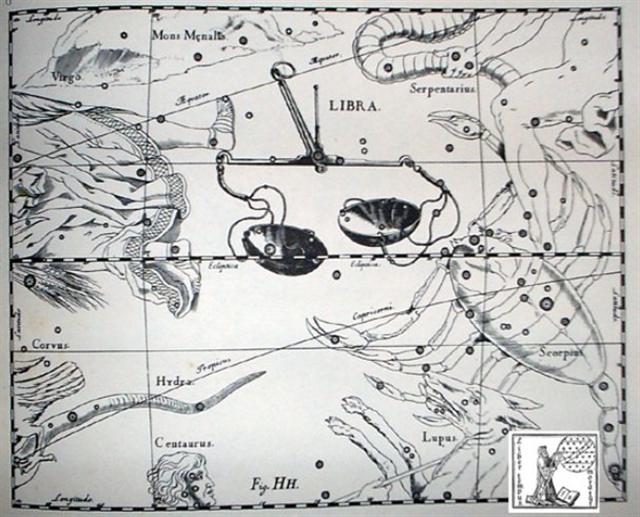


... When this tremendous task had been
accomplished Atea took a third husband, Fa'a-hotu,
Make Fruitful. Then occurred a curious event. Whether Atea
had wearied of bringing forth offspring we are not told, but
certain it is that Atea and her husband Fa'a-hotu
exchanged sexes. Then the [male] eyes of Atea glanced
down at those of his wife Hotu and they begat Ru.
It was this Ru who explored the whole earth and divided
it into north, south, east, and west ...
Since the end of the last ice age the right foot of Virgo had
been pushed ahead in the Sun year with more than a distance
corresponding to half the
precessional cycle of 26000 years. This could explain why she had to
be turned around to show her buttocks (eve, as in evening). Although the
front part of her should remain facing upwards as it always had been.
... Originally the
highly born family of the Sun, Moon, and stars dwelt in a cave
on the summit of Maunga-nui, Great Mountain, in the
ancient homeland. They were not at all comfortable in their
gloomy home for they could not see distinctly and their eyes
watered constantly. After the Sky-father had been elevated to
his present eminence Tane decided that the celestial
family would be happier in the sky, where they would serve the
double purpose of ornamenting the naked body of Rangi and
giving light to the Earth-mother. Since Papa had already
been turned with her face toward the Underworld it is difficult
to see how she would benefit by the illumination ...
3 days after Mimosa (*192 → 4 *
48) was δ Virginis (Minelauva,
the Door of the Barker), and 4 days after Mimosa was
Vindemiatrix (*196):
 |
 |
 |
|
Bb7-4 (13 * 19) |
Bb7-5
(248) |
Bb7-6
(670 = 664 + 6) |
|
ki te maro - ku
hokohuki ia - ki te tagata |
mai tae oho atu ki te
rima - o to haga mama ia - ku hakatepe
ia |
ki to maitaki |
|
Atu. Particle of
meaning opposite to that of mai;
it refers to the second or third person,
expressing movement away:
ka-avai-atu, give it to him:
he-oho-atu au, I am going there,
after you; i-oho-atu-era, when I
had gone there. Vanaga. 1. a. Directive,
of motion from the speaker. b. Somewhat
expressive of the comparative degree. 2.
Pupil; hakaatu, proof; hare
hakaatuga, schoolhouse, class. 3. (hakaatu),
to presage. 4. (hakaatu), mark,
object. Churchill.
Mama. 1. To chew.
2. To mouth-feed (arch.) he-mama i te
vai tôa koia ko te tiapito kiroto ki te
haha o te poki, she mouth-feeds the
child with sugarcane juice together with
tiapito juice. 3. A sea mollusc
(with an eight-horned shell). Vanaga. 1.
To leak, to ooze, (maamaa). P
Pau., Mgv., Ta.: mama, id. 2. To
chew. P Mgv., Mq., Ta.: mama, id.
3. Light not heavy, (maamaa). P
Mgv., Ta.: mama, id. 4. A limpet
(Chiton magnificus). Mgv., Mq.,
mama, a shellfish. 5. To open the
mouth; hakamama, to yawn, to
gape, to be ajar. Pau.: hamama,
to open. Mgv.: akamama, to burst
open. Ta.: haamama, to open. Mq.:
haámama, to open the mouth. 6.
Ta.: mama-orero, conclusion of a
council. Ha.: mama, to finish, to
have done with a thing. Churchill.
Kahu. Clothing,
dress, habit, cloth, curtain, vestment,
veil, shirt, sheet; kahu hakaviri,
shroud; kahu nui, gown; rima o
te kahu, sleeve; kahu rahirahi,
muslin; hare kahi, tent;
horega kahu, shirt; hakarivariva
ki te kahu, toilet; rakai ki te
kahu, toilet; patu ki te kahu,
to undress; kahu oruga, royal
sail; kahu hakatepetepe, jib;
kahu nui, foresail; hakatopa ki
te kahu, to set sail; (hecki keho,
canvas T.) P Pau.: kahu, dress,
garment, native cloth. Mgv.: kahu,
cloth, stuff, garment, clothing. Mq.:
kahu, habit, vestment, stuff, tunic.
Ta.: ahu, cloth in general,
vestment, mantle. Chuchill. |
|
HELIACAL STARS: |
|
April 2 |
3 (29
+ 64) |
4 (459) |
|
JAN
28 |
29
(13 + 16) |
|
|
CIH (Whip)
= γ Cassiopeiae,
λ Tucanae (12.4),
φ³ Ceti (12.6), μ Andromedae (12.8)
*336.0 = *12.4 - *41.4 = 4 * 84 |
φ4 Ceti (13.2) |
No star listed (14) |
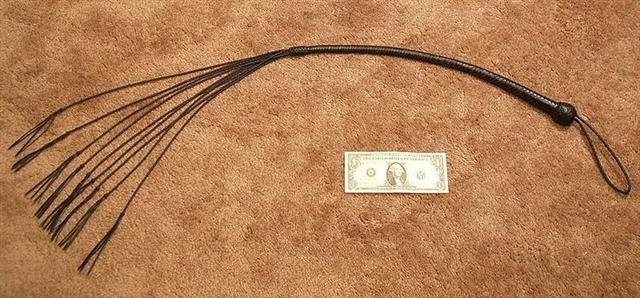 |
|
RIGHT
ASCENSION DAYS AT THE FULL MOON: |
|
Oct 1
(640 - 366) |
2
(275 = 93 + 182) |
3 (94
+ 182) |
|
JULY
29 (210 = 179 + 31) |
30 |
31
(29 + 183) |
|
κ
Crucis (194.4),
ψ
Virginis (194.5),
μ
Crucis,
λ
Crucis (194.6),
ALIOTH (Fat Tail) =
ε
Ursae Majoris,
ι
Oct.
(194.8)
*153.0 = *194.4 - *41.4 = 17 * 9 |
MIN-EL-AUVA
(Door of the Barker) =
δ
Virginis
(195.1),
COR CAROLI =
α
Canum Ven.
(195.3) |
δ
Muscae (196.5) ,
VINDEMIATRIX (Grape Gatherer) =
ε
Virginis
(196.8) |

... The medieval
names Auva, Al Awwa, and Minelauva
are from the Arabic, meaning
'barking (dog)'. This star, along
with β Vir (Zavijava), γ Vir
(Porrima), η Vir (Zaniah)
and ε Vir (Vindemiatrix),
were Al Awwā,
the Barker. On Euphrates it was
Lu Lim, the Gazelle, Goat, or
Stag, - or perhaps King; and, with
ε,
probably Mas-tab-ba,
another of the seven pairs of
Twin-stars of that country.
The
Hindus called it Āpa,
or Āpas,
the Waters; and the Chinese,
Tsze Seang,
the Second Minister of State ...
|

... A young Egyptian called Setna (or Seton
Chamwese) wanted to steal the magic book of Thot from the corpse
of Nefer-ka Ptah, one of the great Egyptian gods, who was often
portrayed as a mummy. Ptah, however,
was awake and asked him: 'Are you able to take this book away
with the help of a knowing scribe, or do you want to overcome me
at checkerboards? Will you
play 'Fifty-Two'?'
Setna agreed, and the board with its 'dogs' (pieces) being
brought up, Nefer-ka Ptah won a game, spoke a formula, laid the
checkerboard upon Setna's head and made him sink into the ground
up to his hips. On the third time, he made him sink up to his
ears, then Setna cried aloud for his brother, who saved him ....
The 'dogs' barking at the fence of the kennel might
have referred to the pieces on a Tafl board.
... There is, however, a remarkable variant
where it is said that he [Kullervo in Kalevala] was 'sent
to Esthonia to bark under the fence; he barked one year, another
one, a little from the third; three years he barked at the smith
of his uncle, at the wife (or servant) of the smith as his
daughter-in-law' ...

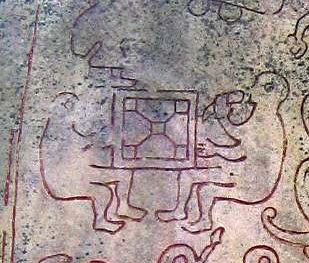
27 days (→ 'thrice
nine hallowed days' → Halloween) after δ Virginis (Minelauva,
the Door of the Barker) had been at the Full Moon then the full moon
was at Rijl al Auva
(the Foot of the Barker), i.e. in the day when the Sun reached
April 30 (120):
 |
 |
 |
 |
 |
|
Bb7-32 (275) |
Bb7-33 |
Bb7-34 |
Bb7-35 |
Bb7-36 (700) |
|
i to huki - o to maro |
e tagata - hua era |
e tagata noho |
ki to manu e |
kua moe koe |
|
April 30 |
May 1 (121) |
2 |
3 |
4 |
|
"March 20 (79) |
21 (0h) |
22 (*1) |
23 |
24 |
|
FEBR 25 |
26 |
27 (58) |
28 |
MARCH 1 |
|
HELIACAL STARS: |
|
π
Ceti,
ο
Arietis (40.0),
ANGETENAR (Bend in the River) =
τ¹
Eridani,
μ
Ceti (40.2),
RIGHT WING = 39 Arietis
(40.9) |
Bharani-2 (Yoni)
/
Stomach-17 (Pheasant)
π
Arietis (41.2),
MIRAM (Next to the Pleiades) =
η
Persei
(41.3),
BHARANI = 41 Arietis (41.4),
τ²
Eridani,
σ
Arietis (41.7) |
TA LING
(Great Mound) = τ Persei (42.4)
*1.0 = *42.4 - *41.4 |
ρ
Arietis (43.0),
GORGONEA SECUNDA =
π
Persei
(43.5),
ACAMAR (End of the River) =
θ
Eridani
(43.6),
ε
Arietis (43.7),
λ
Ceti (43.9)
DENEBOLA (β Leonis) |
MENKAR (The Nose) =
α
Ceti
(44.7) |
|
RIGHT ASCENSION
DAYS AT THE FULL MOON: |
|
Oct 29 (302) |
30 |
31 |
Nov 1 |
2 |
|
"Sept 18 (261) |
19 |
20 |
21 |
22 |
|
AUG 26 (238) |
27 |
28 |
29 |
30 |
|
31 Bootis
(222.0),
YANG MUN (South Gate) =
α
Lupi
(222.1),
RIJL AL AWWA (Foot of the Barker) =
μ
Virginis
(222.5),
ο
Bootis (222.9) |
IZAR (Girdle) =
ε
Bootis
(223.0),
109 Virginis,
α
Apodis (223.3),
μ
Librae (223.8) |
Al Zubānā-14a (Claws)
/
Visakha-16 (Forked)
/
Root-3 (Badger)
ZUBEN ELGENUBI (Southern Claw) =
α
Librae
(224.2),
ξ
Bootis,
ο
Lupi (224.5) |
KOCHAB (Kakkab) = β Ursae Min. (225.0),
ξ Librae (225.7) |
KE KWAN (Cavalry Officer) =
β Lupi
(226.3),
KE KWAN =
κ
Centauri (226.4), ZUBEN ELAKRIBI (Claw of the
Scorpion) =
δ
Librae
(226.8),
π¹
Oct.
(226.9) |
 |
And then the Claws (Al Zubānā) would cover a week.
 |
 |
 |
 |
 |
|
Bb7-37 (280) |
Bb7-38 |
Bb7-39 |
Bb7-40 |
Bb7-41 (284) |
|
i to huki o to maro |
e inoino - ma to huki |
e inoino - i to huki kua haga - i
to maro |
e te inoino e - kua huki koe |
i te tagata |
|
Inoino. Ce qui est éclarante, rayonnant.
Jaussen according to Barthel.
Kino. 1. Bad; kikino,
very bad, cursed; kona kino, dangerous place.
2. blemish (on body). Kinoga, badness, evil,
wickedness; penis. Kinokino, badly made,
crude: ahu kinokino, badly made ahu, with
coarse, ill-fitting stones. Vanaga. 1. Bad, wrong. T
Pau.: kiro, bad, miserable. Mgv.: kino,
to sin, to do evil. Mq.: ino, bad,
abominable, indecent. Ta.: ino, iino,
bad, evil; kinoga (kino 1) sin; Mgv.:
kinoga, sin, vice. 2. A skin eruption,
verruga, blotched skin, cracked feet T. Churchill.
... In South America the rainbow has a double
meaning. On the one hand, as elsewhere, it announces
the end of rain; on the other hand, it is considered
to be responsible for diseases and various natural
disasters [dis-aster]. In its first capacity the
rainbow effects a disjunction between the sky and
the earth which previously were joined through the
medium of rain. In the second capacity it replaces
the normal beneficient conjunction by an abnormal,
maleficient one - the one it brings about itself
between sky and earth by taking the place of water
...
Huki.
1. Pole attached to the poop from which the
fishing-net is suspended: huki kupega. 2.
Digging stick. 3. To set vertically, to
stand (vt.). 4. Huki á te mahina, said of the
new moon when both its horns have become visible.
Vanaga. 1. To post up, to publish. 2. To cut the
throat (uki). Mq.: Small sticks which close
up the ridge of a house. Ha.: hui, the small
uniting sticks in a thatched house. Churchill.
Standing upright. Barthel. M. Spit for roasting.
Te Huki, a constellation. Makemson. Hukihuki.
1. Colic. 2. To transpierce, a pricking. 3. To sink
to the bottom. Churchill. |
|
May 5 |
6 |
7 |
8 (128) |
9 |
|
HELIACAL STARS: |
|
3h (45.7)
GORGONEA TERTIA =
ρ
Persei
(45.1),
ALGOL (The Demon) =
β
Persei
(45.9) |
ι
Persei (46.1),
MISAM (Next to the Pleiades) =
κ
Persei
(46.2),
GORGONEA QUARTA =
ω
Persei
(46.7),
BOTEIN (Pair of Bellies) =
δ
Arietis
(46.9) |
ζ Arietis (47.7) |
ZIBAL (Young Ostriches) =
ζ
Eridani (48.0),
κ
Ceti (48.9) |
τ Arietis (49.7) |
|
RIGHT ASCENSION
DAYS AT THE FULL MOON: |
|
Nov 3 |
4 |
5 |
6 (310) |
7 |
|
"Sept 23 |
24 |
25 |
26 |
27 (270) |
|
AUG 31 (243) |
SEPT 1 |
2 |
3 |
4 |
|
ω Bootis (227.2),
NEKKAR (Herdsman) = β Bootis
(227.3), σ Librae (227.5), π² Oct. (227.7),
NADLAT (Mean Little Ones) = ψ Bootis
(227.8), π Lupi (227.9) |
15h
(228.3)
ZUBEN HAKRABIM = ν Librae
(228.3), λ Lupi (228.9) |
ω
Oct. (229.3),
ι
Librae (229.6),
κ
Lupi (229.7),
ζ
Lupi (229.8) |
Al Zubānā-14b (Claws)
χ
Bootis (230.3),
PRINCEPS =
δ
Bootis
(230.6),
ZUBEN ELSCHEMALI (Northern Claw) =
β
Librae
(230.8) |
μ
Lupi,
γ
Tr. Austr.
(231.3), ο Librae (231.8) |
It is fruitful, we have learned, to arrange similar outstanding glyphs
together:
|
 |
*520 |
 |
|
Ba5-14
(178) |
Bb7-34 (698) |
|
SEPT 25 (268) |
FEBR 28 (788 = 58
+ 2 * 365) |
|
No star listed (*69) |
ZUBEN ELGENUBI (*224) |
... When it was evident that the years
lay ready to burst into life, everyone took hold of them, so
that once more would start forth - once again - another
(period of) fifty-two years. Then (the two cycles) might
proceed to reach one hundred and four [104] years. It was
called One Age when twice they had made the round,
when twice the times of binding the years had come
together. Behold what was done when the years were bound -
when was reached the time when they were to draw the new
fire, when now its count was accomplished. First they put
out fires everywhere in the country round. And the statues,
hewn in either wood or stone, kept in each man's home and
regarded as gods, were all cast into the water. Also (were)
these (cast away) - the pestles and the (three) hearth
stones (upon which the cooking pots rested); and everywhere
there was much sweeping - there was sweeping very clear.
Rubbish was thrown out; none lay in any of the houses
...
.jpg)
|






































.jpg)